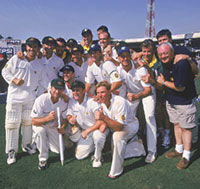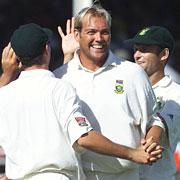Australia No.1, SA No.2
Daniel Laidlaw
Which team is the best? It's a perennial debate among sports fans. In most
sports, it remains a dispute easily decided by fact, as you can usually
point to a league champion at the end of each season. In the haphazard world
of international cricket, though, determining a champion is decidedly more
contentious.
 Soon we will no longer have this problem, as the ICC officially introduces
the world Test rankings and 10-year plan from May 17. When that happens,
Australia will officially be crowned as the No. 1 Test nation. Indeed, the
consensus of opinion in these times before official rankings is that
Australia stands alone at the head of Test cricket.
Soon we will no longer have this problem, as the ICC officially introduces
the world Test rankings and 10-year plan from May 17. When that happens,
Australia will officially be crowned as the No. 1 Test nation. Indeed, the
consensus of opinion in these times before official rankings is that
Australia stands alone at the head of Test cricket.
It is difficult to argue against the credentials of an Australian team that
since defeating the West Indies away in 1995, has considered itself the best
in the world. The rest of the world came into line with that view a few
years later and the recent achievement of 16 consecutive wins, a streak so
famously ended by India last month, certainly reinforces that argument.
Australia's consistent superiority cannot be challenged. Or can it?
The only team that could seriously make that challenge is the mighty, and
equally consistent, South Africa. Both teams have recently completed tough
series, with South Africa becoming only the second team to defeat the West
Indies at home in 28 years, after the Aussies, and Australia losing again in
India. It is the last series each has played before being formally confirmed
No. 1 and 2 in the world.
In determining a No. 1, the first criterion to be considered are the
all-important series results at home and away, which is the sole criteria of
the impending rankings system. Excluding newcomers Bangladesh and Zimbabwe,
neither of whom have toured Australia, at home the Aussies have defeated
every other side in the world in their most recent contest, a highly
impressive feat. The true Test of a team's character and abilities, though,
is how it fares in foreign conditions, and on that front Australia also
rates quite highly, although not as successful as it is at home. In its
previous away series', Australia has defeated all except Sri Lanka and
India, while drawing in the West Indies.
South Africa boast a similarly impressive resume. In its most recent home
series, South Africa has defeated all bar Australia. In its away series' it
has defeated India, Zimbabwe, Pakistan, New Zealand, and West Indies, while
drawing with Sri Lanka and losing to England. Comparing the two, South
Africa can claim a significant edge over Australia in one respect: The
Proteas won their last away series in India and West Indies while Australia
has lost drawn in those countries respectively.
Of greater importance, though, is the head-to-head record of the two
adversaries. Clearly, when records against standard opponents are similar,
the ideal method of deciding the best is to use head-to-head results. In
this most crucial area, Australia leads emphatically. In its previous
contests both home and away, Australia has defeated South Africa.
In 1997, Australia achieved one of its greatest victories of that decade
when it conquered South Africa in the second Test at Port Elizabeth to claim
the series, ultimately prevailing 2-1. After being thrashed by an innings in
Johannesburg, the hosts were on the brink of levelling the series at 87/0 in
the second innings, a lead of 188 on a seaming wicket. A fiery Jason
Gillespie and a spectacular run out by Greg Blewett inspired the comeback,
as South Africa were bowled out for 168 to set Australia the still vast
target of 270. History shows that Mark Waugh (116) played one of his best
Test innings as Australia won a thriller by 2 wickets to clinch the result.
The return series in Australia the following season was marked by the South
Africans as the final chance for a generation of its senior players, like
Brian McMillan, Dave Richardson and Pat Symcox, to achieve their mission of
triumphing in Australia. Mark Waugh again played an instrumental role in by
batting through the final day in Adelaide to preserve a 1-0 lead claimed
thanks to Warne's heroics in Sydney.
These, however, are only the results. That last series was more than three
years ago, when both the Aussies and the Proteas had different captains and
could be considered in different eras. The past can only count for so much
before it is time to examine the current strengths and weaknesses.
 So how do they actually compare? South Africa possesses a decisive edge over
Australia in two departments. Firstly, Australia is a team of elite
specialists, whereas South Africa has that most valuable cricketing
commodity, the genuine all-rounder. And not just one, but three. Jacques
Kallis, Shaun Pollock and Lance Klusener all bring dual assets to the table
with their abilities with both bat and ball. With Steve Waugh no longer able
to bowl, Australia lacks a fifth Test bowling option to call upon in times
of need, while none of its lower order have serious pretensions of
all-rounder status.
So how do they actually compare? South Africa possesses a decisive edge over
Australia in two departments. Firstly, Australia is a team of elite
specialists, whereas South Africa has that most valuable cricketing
commodity, the genuine all-rounder. And not just one, but three. Jacques
Kallis, Shaun Pollock and Lance Klusener all bring dual assets to the table
with their abilities with both bat and ball. With Steve Waugh no longer able
to bowl, Australia lacks a fifth Test bowling option to call upon in times
of need, while none of its lower order have serious pretensions of
all-rounder status.
That leads to the question of depth, where South Africa, due to its surfeit
of all-rounders, also wins out, though not by as much as one would think.
Although South Africa has lower order players of genuine batting ability,
like Pollock and Klusener, the unheralded Aussie tail has consistently
helped to rescue the team. Innumerable times the tail has collectively
supported one of the batsmen in reaching a competitive or larger total that
had seemed beyond it. Despite this valuable asset, South Africa still leads
in this department.
Although South Africa can call upon a wide selection of bowlers, Australia
retains the edge in variation by virtue of its spinners. Australia can
select from South Africa's old tormentor, Shane Warne, Stuart MacGill or
Colin Miller, while South Africa has the less effective spin duo of Nicky
Boje and Paul Adams. Australia also compares favourably to South Africa in
the abilities of its batsmen to play spinners, for despite Harbhajan's
deeds, the positive way it elects to combat spin gives it a telling
advantage over the defensive South Africans.
Finally there is the critical but subjective question of style, addressed
mainly in a previous article. Although both teams play with comparable
aggressiveness in attitude, they embrace differing philosophies, never more
evident than in recent series. Put simply, Australia favours a positive
approach while South Africa prefers the conservative. Both styles have been
effective for the respective teams but the maxim "fortune favours the brave"
holds true. Until such time as the Proteas' results are conclusively
superior to Australia's, the positive intent exhibited by the Aussie batsmen
counts in their favour in a head-to-head encounter.
Australia, notwithstanding what the future may hold, still reigns supreme as
the premier Test team. The ICC table should confirm it next month.
Mail Daniel Laidlaw